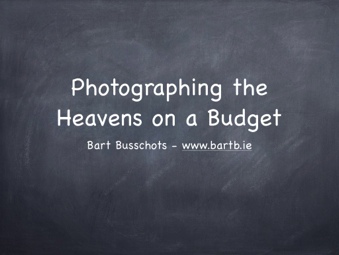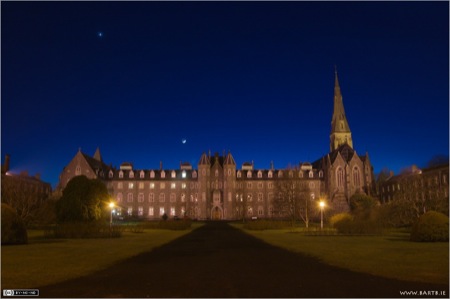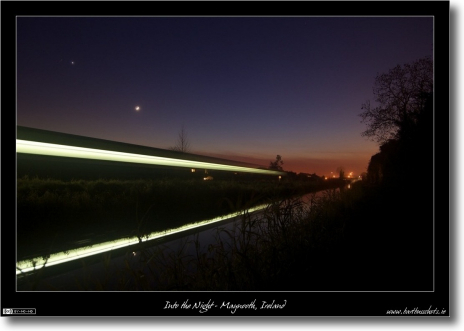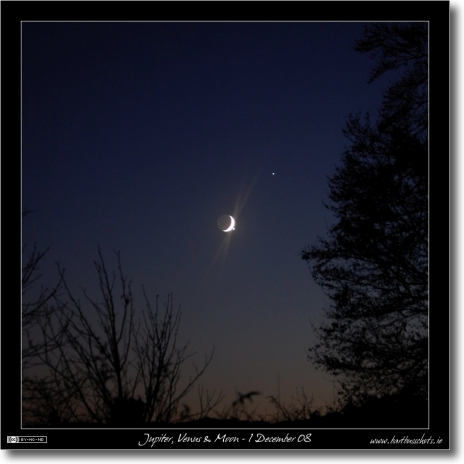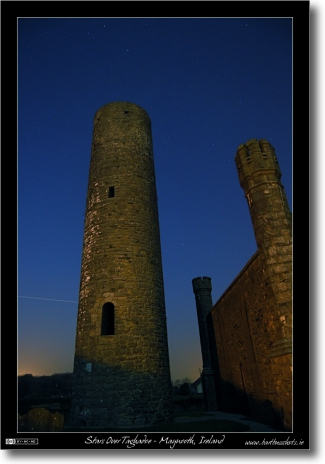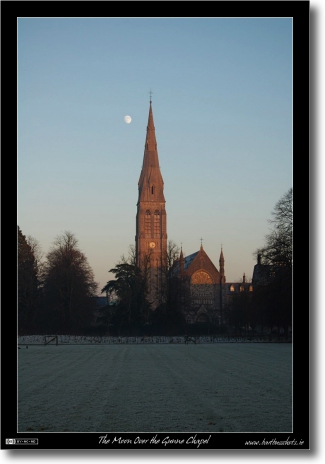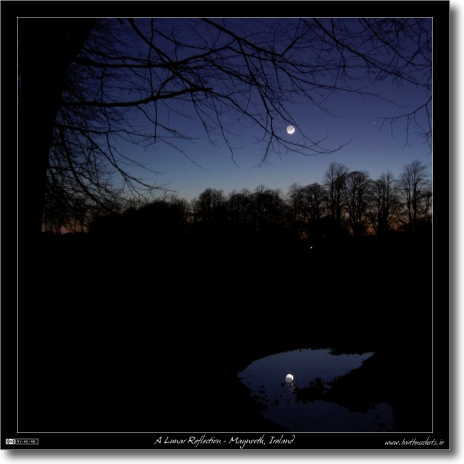Jun
8
Photographing Satellites
Filed Under Science & Astronomy, Photography on June 8, 2013 | Leave a Comment
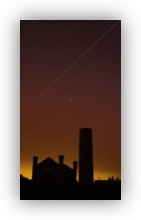
Ireland is actually quite far north, so our summer nights never get fully dark. You watch the sun set, but the glow on the horizon doesn’t go away, it slowly moves from the west through the north to the east where the sun rises again. This takes away a lot of astronomical opportunities, but, when one door closes, another opens. Because the sun never gets far below the horizon during the summer in higher northern latitudes, the part of space where satellites orbit remains in sunlight the whole night long, which means summer is satellite observing time! (The same is true in the southern hemisphere for far southern latitudes during their summer.)
There are lots of ‘ordinary’ satellites which can be seen pass over each night – they look like stars that move slowly but purposefully across the sky – taking a few minutes to cross from one side of the sky to the other. These can be fun to watch, and you can photograph them with a bit of effort, but, the stars of the show are the International Space Station (ISS), which blazes across the sky shining brighter than any star, and the network of Iridium communication satellites
which ‘flare’ regularly. Any satellite can ‘flare’, when the sun glints off a solar panel or communication dish, but those flares are not predictable or dependable. Iridium flares are different, because the Iridium Satellites have massive dishes pointing earthwards at all times, and as they pass over-head, the dish will come into alignment with the sun, and what starts off looking like a regular dim satellite will suddenly brighten for a few seconds and then dim again. The flare is effectively a cone that sweeps the earth, if you are in the very middle of the cone, the flare will be spectacularly bright, down to magnitude -8. For context, the magnitude scale is inverse, so the lower the number the brighter the object. The brightest stars are about magnitude 0, the brightest planets about magnitude -4, and the Moon about magnitude -11, so -8 is getting close to the brightness of the Moon!
Dec
22
Photographing the Heavens on a Budget
Filed Under Science & Astronomy, Photography on December 22, 2012 | 3 Comments
I recently gave a talk to Astro2, the Astronomy and Physics Society in NUI Maynooth. The talk focused on taking photos of the heavens without breaking the bank. If you set your expectations appropriately you can shoot the sky with literally any camera. You’ve not going turn your iPhone into the Hubble Space Telescope of course, but you can always get something nice, even if it’s “just” including the Moon and planets into your landscape shots.
The core idea is that you need to take as much control away from the camera’s computer as possible, so that you can push the device right up to it’s limits. To do that you need to understand how your camera works, so the talk starts with a primer on the theory of photography.
The talk is very heavily illustrated with example photos, and each example comes with a description of the settings used when shooting it.
I was asked in the talk to upload the slide deck, so I have (sorry it took so long).
Jan
29
Tips for Photographing Stars With Basic Equipment
Filed Under Science & Astronomy, Photography on January 29, 2012 | 9 Comments
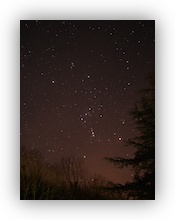 Hard-core astrophotography is very difficult, and requires quite a lot of quite expensive equipment, but, you can do surprisingly much with surprisingly little if you don’t set your expectations unrealistically high. The big problem with the night sky is that it moves. Well, strictly speaking it’s the earth that’s moving rather than the sky, but the point is, stars don’t appear to stand still. Normally when you have a subject that’s dim, you use a tripod and just leave the shutter open for as long as it takes, but since everything astronomical is always on the move, that doesn’t work! The way the pros get around this is with expensive mounts that track the movements of the heavens, opening up the possibility of long exposures. With that problem over-come the pros then run into a whole new set of problems with how noise builds up in sensors over long exposures, so they end up needing some quite advanced techniques and a lot of software and skill as well as the fancy hardware.
Hard-core astrophotography is very difficult, and requires quite a lot of quite expensive equipment, but, you can do surprisingly much with surprisingly little if you don’t set your expectations unrealistically high. The big problem with the night sky is that it moves. Well, strictly speaking it’s the earth that’s moving rather than the sky, but the point is, stars don’t appear to stand still. Normally when you have a subject that’s dim, you use a tripod and just leave the shutter open for as long as it takes, but since everything astronomical is always on the move, that doesn’t work! The way the pros get around this is with expensive mounts that track the movements of the heavens, opening up the possibility of long exposures. With that problem over-come the pros then run into a whole new set of problems with how noise builds up in sensors over long exposures, so they end up needing some quite advanced techniques and a lot of software and skill as well as the fancy hardware.
I don’t have any of the fancy gear, nor any of the fancy software, nor indeed, the skills needed to get good results out of the equipment I don’t have! But, I can still get a descent shot of a star field, and all I need is three things:
- A camera that will allow manual control of the aperture, shutter speed, ISO and white balance, exposure times of up to 30 seconds, and manual focusing or some form of focus lock
- a tripod
- A remote shutter release (or, as a work-around, a delayed shutter release mode)
I did also mention that you need realistic expectations, basically, what we’re aiming for here is shots of large sections of the sky. Think a nice shot of a constellation. If you have visions of detailed views of spiral galaxies in your head – get them out now – that’s for the pros with their fancy kit!
Jan
12
Photo of the Week 152 – Moon & Venus Over SPCM
Filed Under Photography on January 12, 2011 | Leave a Comment
I was looking back through some older shots this week when I noticed this one which I had forgotten to upload to Flickr. I have no idea why I didn’t upload it when I shot it, because it’s one of my best astrophotography shots, nicely and clearly incorporating both the Moon and the Planet Venus into the shot. What at we see here is a view across St. Joseph’s Square in St. Patrick’s College Maynooth (SPCM)looking towards St. Patrick’s House with the spire of the College Chapel also visible. In the top left of the shot you can see Venus, and just above the building you can see a very thin crescent Moon with a lot of Earth Shine. This shot was taken with a tripod because it was dark and a four and half second exposure was needed.
- Camera: Nikon D40
- Lens: Nikon DX AFS 18-55mm (D40 kit lens)
- Exposure: 4.5 sec (shot on tripod)
- Focal Length: 19mm
- Focal Ratio: f/8
- ISO: 200
- Camera Mode: Aperture Priority
- Exposure Bias: -3.0ev
Jan
11
Photo of the Week 47 – Into the Night
Filed Under Photography on January 11, 2009 | 3 Comments
As a friend of mine put it on Flickr, this photo combines my three nerdy hobbies, Astronomy, Photography, and trains. This is a 5 second exposure of a commuter train approaching Maynooth reflected in the waters of the Royal Canal in the late evening while Venus & the Moon shine over-head. This is a shot I’d tried before, and each time I learned a few more valuable lessons. So, although this is the result of a learning experience, I’m still shocked at how lucky I was to get everything to line up as well as it did. The train, the reflection, the silhouette of the tree, those things I could control, but the positions of the Moon and Venus, those were a pure bonus! Anyhow, if I had to pick my three best photos yet, this is one I’d definitely choose.
- Camera: Nikon D40
- Lens: Nikon DX AFS 18-55mm (D40 kit lens)
- Exposure: 5 sec
- Focal Length: 18mm
- Focal Ratio: F5
- ISO: 200
- Camera Mode: Manual
- Exposure Bias: -2.0
Dec
7
Photo of the Week 42 – Jupiter, Venus & the Moon
Filed Under Photography on December 7, 2008 | Leave a Comment
Last Monday (1 December 2008), the Moon, Jupiter & Venus were in a very close conjunction in the sky. For the non-astronomers amongst you that just means they were very closely placed in the sky. In fact, they were so close that Venus actually passed behind the Moon! This week’s photo of the week if my favourite shot of the event, you can see the rest of my shots in this Flickr Set.
This week’s photo of the week was taken not long after Venus re-appeared from behind the Moon. You can see it just off to the right of the think crescent Moon. Jupiter is the bright point of light above and to the right of the Moon.
For those of you interested in such things, here are the technical details of this shot:
- Camera: Nikon D40
- Lens: Nikon DX AFS 55-200mm
- Exposure: 1.5 sec
- Focal Length: 70mm
- Focal Ratio: F4.5
- ISO: 400
- Camera Mode: Aperture Priority
- Exposure Compensation: -1.0
Jun
15
Photo of the Week 17 – Stars Over Taghadoe
Filed Under Photography on June 15, 2008 | Leave a Comment
I shot this photo quite a few months and all but forgot about it. It sat un-processed and forgotten in a dark corner of my gallery gathering electronic dust until I stumbled across it yesterday. The raw image didn’t look too promising, the whole thing had a very nasty red colour cast and didn’t look at all appealing. Some fairly extreme twiddling with sliders in iPhoto managed to turn this ugly duckling into a beautiful swan! The moral of the story, don’t be too put off when your shots don’t look great straight out of the camera! To give you an idea of how much editing had to be done I’ve included a small version of the original below.
If you’ve been following this series you’ll have seen Taghadoe before, this is the same round tower you saw silhouetted in Photo of the Week 5 – Nightfall in Taghadoe. It’s a real hidden gem located just a few miles outside Maynooth Village in Co. Kildare, Ireland.
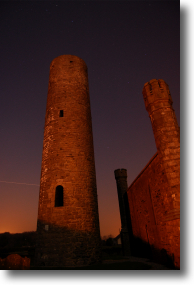 For those of you interested in such things here are some of the technical details of the shot:
For those of you interested in such things here are some of the technical details of the shot:
- Camera: Nikon D40
- Lens: Nikon DX AFS 18-55mm (D40 kit lens)
- Exposure: 14.6 sec (using tripod)
- Focal Length: 18mm
- Focal Ratio: F3.5
- ISO: 800
- Camera Mode: Manual
- Exposure Compensation: -1.0
[tags]Photography, Maynooth, Ireland, Kildare, Taghadoe, Round Tower, astrophotography, stars, night[/tags]
May
25
Photo of the Week 14 – The Moon Over the Gunne Chapel
Filed Under Photography on May 25, 2008 | 3 Comments
I took this shot back in December last year as the sun was setting after work. This shot was taken as a very special time of the day, when you can expose both the landscape and the Moon correctly in a single exposure.
The shot shows the Moon over the Gunne Chapel (AKA the College Chapel) on the campus of St. Patrick’s College in Maynooth, Ireland. This campus is also shared with NUI Maynooth.
For those of you interested in such things here are some of the technical details of the shot:
- Camera: Nikon D40
- Lens: Nikon DX AFS 18-55mm (D40 kit lens)
- Exposure: 1/200 sec
- Focal Length: 45mm
- Focal Ratio: F5.6
- ISO: 200
- Camera Mode: Aperture Priority
- Exposure Compensation: 0.0
[tags]Photography, Maynooth, Ireland, Moon, church, spire[/tags]
May
4
Photo of the Week 11 – A Lunar Reflection
Filed Under Photography on May 4, 2008 | 2 Comments
Although planning and preparation are very important in photography, some of the best shots are still happy coincidences. This is the perfect example of such a shot. I thought I’d figured out the exact shot I wanted so I was making my way to the spot I’d chosen very carefully when I glint of reflected moonlight hit my eye. I stopped my bike immediately and managed to get this shot after a few attempts.
I took this shot not long after sunset on an evening early last month from the edge of the playing fields on the campus of St. Patrick’s College in Maynooth, Ireland.
For those of you interested in such things here are some of the technical details of the shot:
- Camera: Nikon D40
- Lens: Nikon DX AFS 18-55mm (D40 kit lens)
- Exposure: 6 Sec
- Focal Length: 28mm
- Focal Ratio: F4.2
- ISO: 800
- Camera Mode: Aperture Priority
- Exposure Compensation: 0.0
[tags]Maynooth, Ireland, Moon, Reflection[/tags]
Mar
21
Tips for Shooting the Moon
Filed Under Photography, Science & Astronomy on March 21, 2008 | 1 Comment
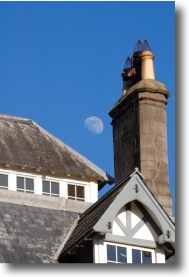 It can be very nice to include the Moon in your shots of buildings or landscapes but it’s not easy. The reality is that the Moon is very small in the sky and that it’s hard to pick up detail on the Moon while also properly exposing your subject. That’s why so many people cheat and get the Moon into their shots using PhotoShop. They stick on a massive zoom lens, shoot the Moon, then stick on a normal lens to shoot their subject and finally combine the two shots into one. If that’s the way you want to do things that’s your call, personally I look at it as cheating and would prefer to do it the hard way and actually capture the Moon and my subject in a single shot.
It can be very nice to include the Moon in your shots of buildings or landscapes but it’s not easy. The reality is that the Moon is very small in the sky and that it’s hard to pick up detail on the Moon while also properly exposing your subject. That’s why so many people cheat and get the Moon into their shots using PhotoShop. They stick on a massive zoom lens, shoot the Moon, then stick on a normal lens to shoot their subject and finally combine the two shots into one. If that’s the way you want to do things that’s your call, personally I look at it as cheating and would prefer to do it the hard way and actually capture the Moon and my subject in a single shot.
[tags]photography, DSLR, the Moon[/tags]







